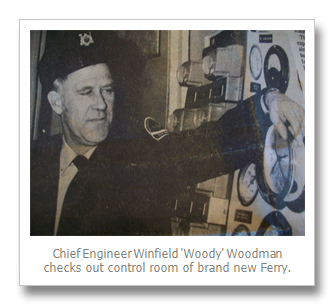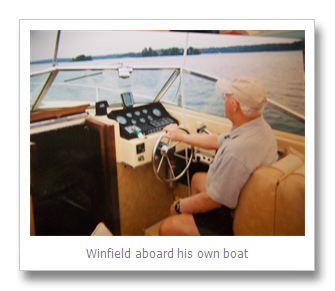This year, thousands of young Canadians all across Canada are going to be flocking to training schools to learn to fly, many for preparedness reasons... NO ACCIDENTS PLEASE! The Kingstonaire, Kingston Flying Club, Jan. 3, 1951
“I thought to myself, I just want to get down in one piece... I don’t want them fishing for my body way out here...”Winfield ‘Woody’ Woodman
A Wolfe Island boy’s first solo flight, Dec. 31, 1950
Norman Rogers Airport is located just west of downtown Kingston out on LeMoine’s Point. In 1950, four active runways led out over wild, Lake Ontario.
On December 31, 1950, a lone Fleet Canuck, CF- DYZ was about 1000 feet over Lake Ontario, cutting its engine as it turned on a final approach to snow covered runway ‘30’. Down below, large cakes of ice ground together in the heavy swells now rolling in off the Lake due to the brisk, north-westerly wind.
Inside the small plane, pilot-instructor George Hurren, seated to the right, beside his pupil, watched as the student lined-up the aircraft for its descent. Bouncing slightly in the turbulent cross wind, nineteen year old Winfield ‘Woody’ Woodman cut the power a little more and held the aircraft in a proper attitude, while watching his airspeed carefully.
Flaring out gracefully, the airplane’s steel skis skimmed the snow covered surface of the former grass runway. George tapped his student on the arm and asked him to taxi across the field, back toward the hanger, rather than take-off again. “Boy, you’re just a natural at this,” Hurren yelled over the engine. “OK,” he said, “stop ‘er right here.”
Winfield cut the engine and the small, yellow two-seater plane stopped in the snow. With the engine idling, George opened his door on the right side and climbed out. Turning, the Chief Flying Instructor of the Kingston Flying Club said to his student, “You’re on your own. See you in a few minutes.”
With that, Hurren shut the door and tapped the top of the fuselage. As he stepped back, he saw young Woody go over his checklist, moving the control stick forward and back and side to side. At the same time, the airplane’s elevator moved up and down while the ailerons moved up and down alternately, like they were supposed to.
Pre-flight over, Woody gunned the Continental C-85 four cylinder engine. The plane slowly rolled forward then turned into the wind. Checking the sky for other aircraft, Woody saw that it was clear and lined the airplane up at the end of the hard packed runway. He then shoved the throttle all the way forward. With engine roaring, CF-DYZ started down snow covered runway ‘three zero’ rapidly gaining speed. Stick slightly forward, the tail came up and then Woody pulled slightly back. The airplane lifted off the runway. Bouncing slightly in the headwind, Woody glanced at his instruments, carefully noting his airspeed and altimeter, keeping her nose slightly up, as he headed up and over Collins Bay. Down on the ground, George Hurren watched his pupil climb out gracefully, climbing up to the required height before turning crosswind. Not bad for a student who only began flying a few weeks ago.
That’s it, he thought, keep her climbing ... up... up... Just then, to his horror, he heard the engine cut out.
Frozen, the instructor could only watch - helpless - as his pupil suddenly put the plane’s nose down and drop his left wing in a turn. He was only 300 feet up and dropping. It was hopeless.
______________________________________________
Before the year 1940, Kingston had a grass airstrip just north of the city. When World War II broke out, a much larger airfield was built to the west of the city to serve as a training station for the Royal Air Force’s No. 31 Service Flying Training School. The twinned runways formed the classic triangle pattern. Named after Norman Rogers, the Minister of Defence who was killed in a local plane crash in 1940, the airfield and school became part of the British Commonwealth Air Training Plan. Its No. 14 Service Flying Training School moved to Kingston in 1944 and merged with the RAF school.
Student pilots were trained in Harvard’s, Yale’s and Anson’s before being sent overseas. Relief landing fields were located in nearby Gananoque and Sandhurst. At war’s end, the Flying Training School was closed. The Kingston Flying Club, established in 1929 at the former grass airstrip, took over the eastern hanger shortly after. In 1950, many young men and women were flocking to the local flying schools and clubs, now located on many deserted RAF training airfields.
Including one young Wolfe Island boy who had only 3 hours of instruction before going solo.
The instant the engine lost power, Woody put the nose of the plane down to maintain airspeed. “I was told I did exactly as instructed,” recalled Winfield Woodman, some 60 years later. “Well, that’s true to a point. I kept my airspeed up but you’re instructed in a power failure after takeoff to pick a spot ahead – don’t try and turn – you’re not going to make it. Well, to me, I didn’t have a choice. I was headed northwest, right over Collins Bay with floating ice cakes right below. I thought to myself, well, I don’t want them fishing for my body way out here... the things that run through your mind so quickly. What really saved the day for me was a strong northwest wind. I stuck her nose down to keep airspeed and came around as quick as I could. I didn’t lose a whole lot of altitude, but then the wind being as strong as it was. pushed me right back over the airport.”
Finding himself lined perfectly crosswind, Woody pulled slightly back on the stick, flaring-out over the cleared pavement of the taxi strip! As he settled down, sparks flew as the metal skis came in contact with the cleared strip. “I just wanted to get down in one piece, you know? George came running up and was proud that I was able to do it.” After getting his shirt tail clipped, a flying club tradition, Woody took off again, thirty minutes later... back on the horse, as they say. The problem? A spark plug flew out of the front port cylinder.

Growing up on Wolfe Island, Winfield was born and raised in the Woodman House Hotel in the village of Marysville. Being close to the water, Winfield and his late brother Bruce helped their father Stan with his guiding business, taking tourists out to the best fishing spots of the Thousand Islands during the summer months. Commuting to Kingston, especially in the winter months, was almost always an ordeal if the ice was soft. Building himself an iceboat, complete with the huge propeller in back, Winfield realized this was probably the first time the ‘flying bug’ hit him. “Oh, dad was furious with me,” he recalled. “Figured I’d kill myself on it.” Later, with the Korean War on, Woody didn’t want to tread in the trenches. “I figured if I had a pilot’s license, I would stand a better chance of surviving.”

Learning his mechanical trade at the Kingston Locomotive Plant, Woody joined the Wolfe Island Ferry Service in 1964, retiring as Chief Engineer in 1991. A fairly routine job until the coming of the complicated mechanism of the brand new Wolfe Islander III, in 1975. Winfield laughs as he recalls those early years. “The new boat was a nightmare for the first year. All the electronics and wiring...” However, he and his engineer team slowly got the bugs out, taking their time, studying the layout prints and tracing every small detail. When he retired, Woody took up flying again.
“I had to start over, because that time from before, well, it doesn’t count,” he said. Re joining the Kingston Flying Club, Winfield soon had his wings again. “My second first solo was on October 16, 1990. It wasn’t quite as eventful,” he said, laughing. By now, many changes had happened in the world of recreational flying. “Before you get your license today, you must have so many hours of IFR (Instrument Flight Rules) time before your flight test,” Winfield said. “But, I just turned 80. I’ve had a good go at it. I quit flying on August 14, 2007.”

Today, according to present Chief Flying Instructor Tony Tiefenbach, also a new resident of Wolfe Island, the Kingston Flying Club is now certified as the city’s newest career college, under the Ontario Colleges Act. “I worked in Ottawa for many years as a flight instructor,” Tony said, “and I found that many students drove in from Kingston and area for training. When I moved to this area recently I was fascinated with the remarkable history of the Flying Club and its people over the years. What an opportunity to create a ‘flight college’ where students could work their way up to eventually obtaining Airline Pilot status.” Pilot Ground School, where would-be pilots receive instruction for their written exams, was just held late this fall at the flying club. All six students graduated, with one thirteen year old boy coming second in his class.
In keeping with tradition, pilots of the Kingston Flying Club do a City Fly-Over, every New Year’s Day around 11:00 am. Their route also passes the outer perimeter of Wolfe Island. According to local flying club lore, if you fly this event, you’ll have good luck for the remainder of the year.’
Now who do you suppose started that tradition?
By Brian Johnson, Wolfe Islander III Captain and former flying student at the Kingston Flying Club. who had an uneventful first solo on March 30, 1970.
Brian Paul Johnson is one of five captains of the Wolfe Island Car Ferry, “Wolfe Islander III.” He has worked for the Ontario Ministry of Transportation for more than 30 years, recently celebrating 20+ years as Captain. We often see him pass-through the islands as Captain of the “Canadian Empress.” Today, Brian combines his marine career with writing. Fascinated by stories and legends of the 1000 Islands area, he has written for the “Kingston Whig Standard,” “Telescope Magazine,” the “Great Lakes Boatnerd” and the website:“Seaway News”. Brian co-edited “Growing up on Wolfe Island”, a compilation of interviews and stories with Sarah Sorensen. He is also a past president of the Wolfe Island Historical Society and former president of the Wolfe Island Scene of the Crime Mystery Writer’s Festival, held on the island every August.
To see all of Captain Johnson’s articles for TI Life, Click Here.
This story first appeared in the Kingston Whig Standard Dec. 30, 2011.